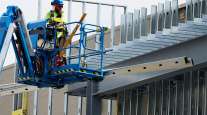US Economic Growth Not So Bad After Revisions to Spending, Investment

The U.S. economy’s first quarter wasn’t so miserable after all, as consumption contributed more to growth and business investment was even stronger than thought, Commerce Department data showed May 26.
Highlights of First-Quarter GDP
• Gross domestic product rose at 1.2% annualized rate, revised from 0.7% (economist estimate 0.9%).
• Consumer spending, the biggest part of the economy, rose 0.6%, revised from 0.3% (economist estimate 0.4%).
• Revisions were led by utilities consumption, intellectual-property investment, government and private construction.
Key Takeaways
While the revisions were more positive than economists generally expected, the report reinforces that 2017 got off to a relatively weak start, a trend that’s plagued the U.S. economy for several first quarters. Still, business investment was even brighter than previously estimated, thanks to fresh data on construction spending and companies’ research and development expenses.
Economists and Federal Reserve policymakers are betting on a second-quarter rebound with the consumer leading the way, as Americans remain confident amid steady job growth and the promise of fatter paychecks.
Part of the revision to consumption spending was due to electricity-usage data for February, indicating that heating bills during the unusually warm weather weren’t as low as thought. That drag from low spending on energy is one of the reasons that economists view the first-quarter slowdown as transitory.
Other Details
• Inventories subtracted 1.07 percentage point from growth in January through March, revised from 0.93 percentage point.
• Net exports added 0.13 percentage point to GDP growth, revised from addition of 0.07 point.
• Stripping out inventories and trade, two most volatile components of GDP, so-called final sales to domestic purchasers increased at 2.1% rate, revised from 1.5%.
• Nonresidential fixed investment, or spending on equipment, structures and intellectual property, rose at 11.4% annualized pace, a five-year high, revised from 9.4%.
• Health care spending revised lower to 0.10 percentage-point contribution to growth, from 0.37 point.
• Real disposable personal income rose at 1.7% pace in first quarter, revised from 1%, as fourth-quarter wages and salaries were revised down by $106.2 billion.
Corporate profits rose 3.7% from a year earlier, the third straight gain.
U.S. economy will grow at 3% rate in the second quarter and 2.2% for the year, according to median forecasts in Bloomberg surveys of economists earlier this month.
GDP report is the second of three estimates before annual revisions in July.




